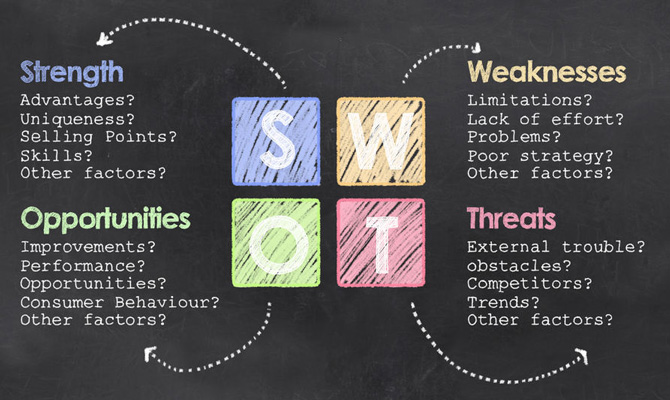Sometimes it pays to structure our thinking. While you might have a ton of great ideas, a keen insight and critical mind; even the greatest of minds will sometimes need to be given some guidance and structure.
That is why ‘thinking tools’ like the SWOT analysis can be so useful. This is simply a structured approach to a problem or an idea that can help to present opportunities and pitfalls in order to help you create the very best outcome. ‘SWOT’ is simply an acronym that defines a set number of steps that you can take when assessing an idea or coming up with a plan. As we will see, it can be highly useful for business but also for a range of other situations – whether you’re planning a holiday with family and friends or whether you want to start a new training program to tone your muscle and lose weight.
How Does it Work?
SWOT stands for: strengths, weaknesses, opportunities, threats.
So, let us say that we are thinking of starting a new website that’s all about dog memes. First, we would look at the strengths of this idea: people love dogs, people love memes, this kind of thing has massive viral potential, it would be easy to get lots of content for free…
Next, we would look at the weaknesses. In this case, we could point out that there’s a fair amount of competition in this niche, that it would be hard to monetize (most items you would sell from such a website would be cheap and disposable) and that the content you’d create wouldn’t be very meaningful or Google-friendly.

Opportunities? Well, we could work with established sites like Buzzfeed potential due to the viral nature of the subject. Likewise, we might be able to work with dog celebrities on Instagram like Marnie. Maybe we could strike up a deal with a cat meme site?
Threats would basically include any risks that could be posed to this business plan. There’s the risk that we might get the tone wrong for instance and be seen as out of touch, rather than appealing to a social media savvy, hip, young crowd. Likewise, you might risk issues with copyright. Then there’s the obvious risk that the project may be unsuccessful after you’ve already invested a lot of money into it…
And with that, we have completed a SWOT analysis of our proposed business plan and hopefully as a result, we should have a much better idea of what the plan entails and what its various strengths and weaknesses are.
Using This Tool
The great thing about the SWOT structure is that it can also be applied to various other aspects of your life. For example, you could use SWOT to assess your plan to lose weight or to plan a holiday. In doing this, you are applying the same kind of inventive and critical thinking to various areas of your life that you would expect to see from a business about to take on a large new project.
What this essentially does, is to encourage you to think about future possibilities and to that way prepare yourself for the best possible outcome. By thinking about the possible opportunities for instance, you will be more likely to be able to take full advantage of those strengths and thereby to get the best outcome. If it’s a training program, that means you’re more likely to stick at it. If it’s a holiday, it means you won’t miss out on the incredible things that the country or the week off have to offer.
Likewise though, it is also prudent to always be mindful of things that can potentially go wrong. While no one likes to dwell on the negative, it is important to think about possible pitfalls if you hope to be able to combat and prevent them. By imagining ‘counterfactual scenarios’ (in other words: possible futures) you can ensure that you are prepared for any outcome and that you are well poised to deal with it. Better yet, it hopefully means that you can avoid those negative outcomes entirely! In some cases, you might even decide not to go ahead with the project at all – but that’s better than finding out too late that it wasn’t a good idea!
So next time you have a project, whether that’s a personal project or a business project, consider carrying out a quick SWOT analysis in order to best prepare yourself for what lies ahead.




